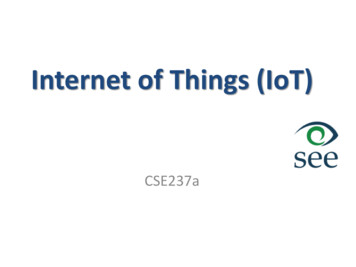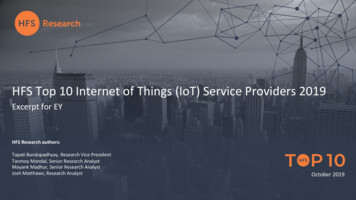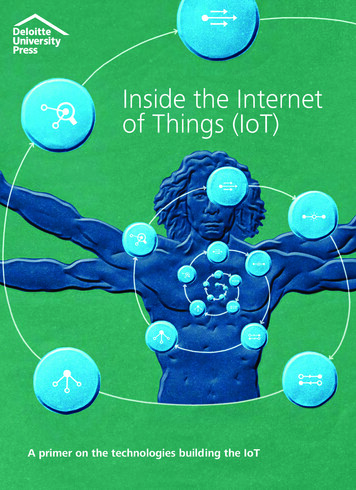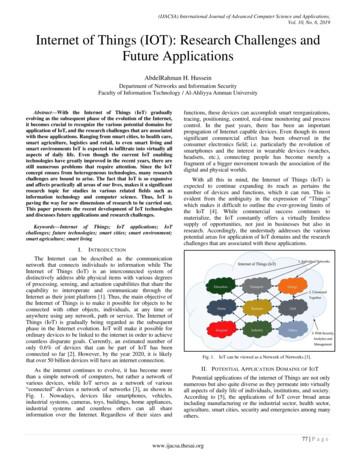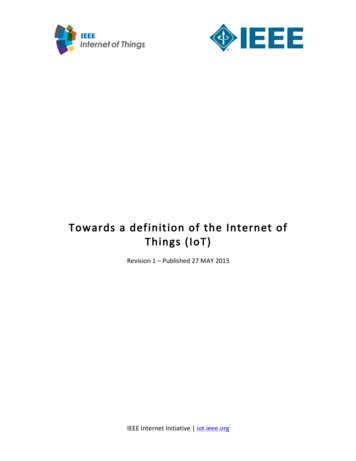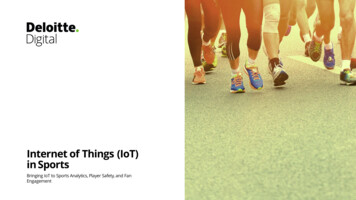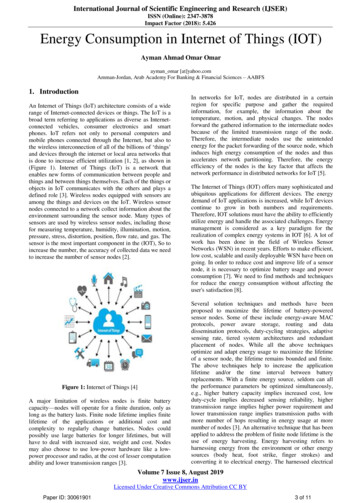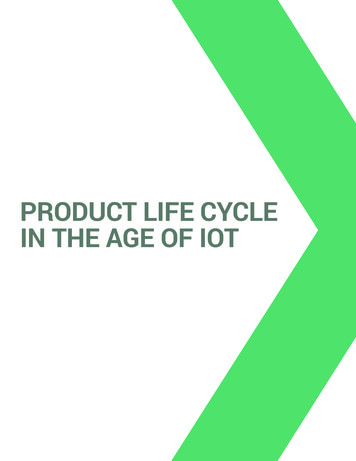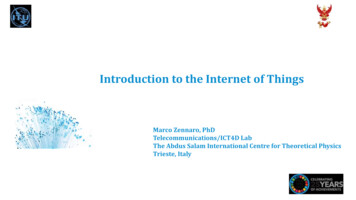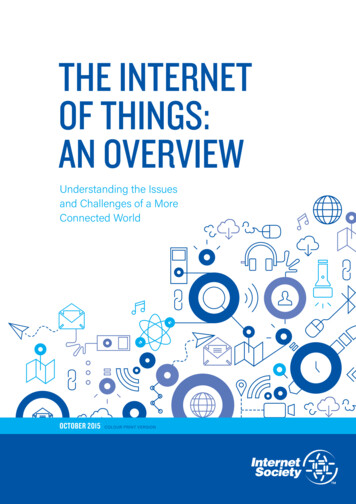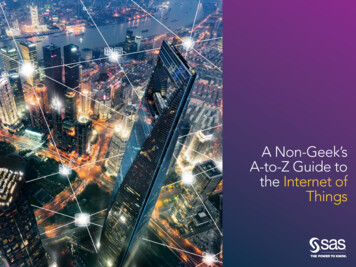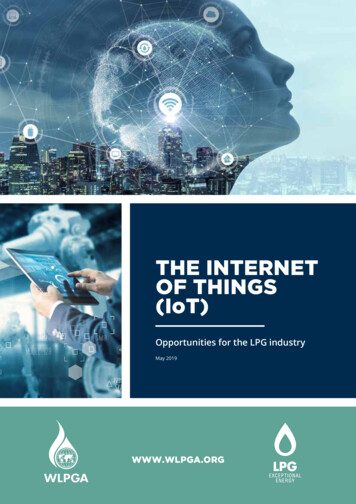
Transcription
THE INTERNETOF THINGS(IoT)Opportunities for the LPG industryMay 2019WWW.WLPGA.ORGTHE INTERNET OF THINGS (IOT)01
02THE INTERNET OF THINGS (IOT)
CONTENTSACKNOWLEDGEMENTS AND PARTICIPANTS OF THE WORKING GROUP05EXECUTIVE SUMMARY06OBJECTIVES12METHODOLOGY AND STRUCTURE16GLOBAL OVERVIEW1. D efinition of IoT2. D escription of the current and evolving landscape of key IoT technologies andcommunication networks3. The key IoT players4. W hat IoT deployments have transformed other industries? Identify keyadvancements made in other industries5. What lessons can we learn from those deployments?181820IOT IN LPG1. H ow could IoT provide more information and control over LPG assets? Scope andidentify applications across the entire LPG supply chain? How could it help the LPGindustry?2. W hat information are companies lacking to make infrastructure investments?3. S hort, medium and long-term technologies that could be rolled out across theindustry3232EXAMPLES OF IOT IN THE LPG BUSINESS1. The Blue Room - UltraGaz2. Digitally Controlled Oilfields - Ingenu3. Integrated Filling Plants - Indian Oil Corporation4. Bulk Tank Monitoring - ISA Sensing5. The Road to 60% Average Fill - Silicon Controls6. Cylinder Smart Meter - PayGo Energy7. Driver Efficiencies - CEFA8. Meter Tracking - DreamTec9. Smart Tank Technology - Superior Propane10. The Challenge - Vodafone11. RFID - Trovan12. Driverless Operations - Roy Hill38383940424344484950515253STANDARDS & REGULATIONS1. Assess the regulatory landscape2. C an we develop new common standards for the use of IoT across the industry?545455APPENDIX ONE – POWERPLAY56APPENDIX TWO - WEBINARS59APPENDIX THREE - COMMUNICATIONS TECHNOLOGY BY COUNTRY60APPENDIX FOUR - REFERENCES & LINKS61THE INTERNET OF THINGS (IOT)232630353603
04THE INTERNET OF THINGS (IOT)
ACKNOWLEDGEMENTS AND PARTICIPANTS OF THE WORKING GROUPThe World LPG Association (WLPGA) would like tothank everyone involved in the production of thisreport.David Tyler produced the initial draft with valuableassistance from Andre Pimentel of ISA Sensing.IoT ContactCompanyThe following members of the working groupagreed the terms of reference, provided initialfeedback to a questionnaire and helped withthe final drafting. This feedback, together withcomments on subsequent drafts, formed thebasis of the final report.CountryMakoto ArahataJapan LPGJapanTim BauerEnvirofitUSAOlivier BecqSiragaFranceMatteo CompagnoniCavagnaItalyMark DirksRegoUSAMarkus DreierUGIUSAOlivier EudelineButagazFranceMarcos Paulo FerrazCopagazBrazilMs. Luanna Marche FioravanteUltragazBrazilPaula FrigerioAbastibleChileEric HahnElgasAustraliaJoost KorverSHVNetherlandsFausto MarcigotPaygo EnergyKenyaMs Barbara MasinEID LtdUSACedric MorelSensileSwitzerlandCinch MunsonPERCUSAMike NeumanSilicon ControlsAustraliaJ P PandeyIOCIndiaFilipe PedrosaAmtrol-AlphaPortugalTucker PerkinsPERCUSAAndre PimentelISASensingPortugalThe WLPGA would also like to thank everybodyelse who participated during the drafting.Especially those who attended the IoT powerplaysession, held during the World LPG Forum inHouston, USA, in October 2018 and those thatjoined the two WLPGA IoT webinars held duringNovember 2018.THE INTERNET OF THINGS (IOT)The full minutes of the powerplay and a link to thewebinar recording are included in Appendix Threeof this report. Some of the feedback from theseevents is also included in the main body of thisreport.05
EXECUTIVESUMMARYThe Internet of Things, or IoT, refers to the growing range of internetconnected devices that capture, or generate, an enormous amount ofinformation every day. It has been described as a development of theInternet in which everyday objects have network connectivity, allowingthem to send and receive data.“TELEMETRY IS AN AUTOMATEDCOMMUNICATIONS PROCESS BY WHICHMEASUREMENTS AND OTHER DATA ARECOLLECTED AT REMOTE/INACCESSIBLEPOINTS AND TRANSMITTED TO RECEIVINGEQUIPMENT FOR MONITORING”Telemetry has been used in the LPG industry formany years, mainly for monitoring stocks in thebulk LPG sector where the cost was more easilyjustified. Initially direct phone lines were usedto transmit measurements and data before thecellular networks were introduced. Now the powerof the internet cloud is being harnessed whichis opening new opportunities across the wholebusiness.06The report addresses two main issues: What are the main developments happening inthe IoT space? How can they be applied to the LPG industryfrom production, through primary andsecondary storage to the distribution channeland onto the end user?THE INTERNET OF THINGS (IOT)
KEY OBSERVATIONS THAT ARE MADE IN THIS REPORT ARE: IOT IS ONE OF THE MOST GAME-CHANGING EVENTS FACING THE LPG INDUSTRY DEVELOPMENTS IN IOT ARE CHANGING FAST AND NEED TO BE CONSTANTLY MONITORED IOT WAS NOT PART OF THE WLPGA STRATEGIC PLAN THREE YEARS AGO THERE ARE MANY COMPANIES, INCLUDING START-UPS, DEVELOPING EXCITING TECHNOLOGY T HE LPG INDUSTRY IS LAGGING OTHER INDUSTRIES IN THE APPLICATION OF IOT, ESPECIALLYIN OPERATIONS ASE STUDIES OF LPG IOT APPLICATIONS ARE LIMITED - COMPANIES ARE UNWILLING TOCSHARE SUCCESS BUT EXAMPLES FROM OTHER INDUSTRIES MAY BE APPLICABLE THE CAPITAL INTENSITY OF THE LPG INDUSTRY PROVIDES OPPORTUNITIES FOR IOT ‘START SMALL AND EMBRACE CHANGE’ BRING IOT ‘OUT OF THE GARDEN INTO THE HOUSE’ KEEP INVESTING IN IOT OR THE INDUSTRY WILL BE LEFT BEHIND OPPORTUNITIES EXIST FOR ORGANISATIONS TO JOIN FORCES TO EXPLOIT IOT IOT APPLICATION NEEDS CONTINUOUS COMMITMENT FROM TOP MANAGEMENT THE INTERNET OF THINGS (IOT)07
The significant improvements with the evolutionof communications over the last fifteen years hasenabled the internet cloud to store data ratherthan retain it on the ground, reducing cost.Bulk customers require on-site storage tanks,supplied from road tankers serviced fromdepots with their own bulk storage facilitiesand loading gantries.An example is the way transponders, or tags, havenow become just the links to cloud data allowingthem to be much simpler and cheaper devices,and opening opportunities to monitor low costassets such as small cylinders.These assets require inspection, servicing andmaintenance to ensure they are continuallysafe and fit for purpose. They also need to befully utilised.The IoT has created an opportunity to nowmanage these LPG assets, and also, to improvethe way the LPG industry operates.The LPG industry is very capital intensive. Forevery cylinder delivered to a household, there aretwo or three more cylinders at the filling plant orin the distribution chain, in support.The IoT generates massive amounts of data.Cloud computing provides a pathway for thatdata to travel to its destination.It is estimated by Cisco IBSG that by 2020there will be 50 billion devices connected tothe internet, a one-hundred-fold increasecompared to 2005.Cisco IBSG estimate that by 2020 there will be 50bn devices connected to the internet08THE INTERNET OF THINGS (IOT)
The world’s population will have increased by just20% in the same period.So IoT is here, and growing very fast, but there areconcerns about its adoption.According to Morgan Stanley, their WorldIndustrial Automation Survey concluded that 46%of respondents put security as the most seriouschallenge to IoT adoption.The LPG industry has been described as ‘ atleast ten years behind the telecommunicationsindustry when it comes to the adoption of newtechnologies ’.And, according to Forbes, the worldwide spendingby the energy and natural resources sector on IoTis relatively low compared to other industries.Other challenges identified included a lack ofstandardisation (35%), up-front investment(30%), return on investment (ROI) (27%), and dataintegrity (23%).Some of these concerns were mirrored in thefeedback received during the development of thisreport.Lego man with a 18mm tagInternet spending by sector according to Forbes - 2018THE INTERNET OF THINGS (IOT)09
If the LPG industry is so far behind, thenthe adoption of IoT could present some realopportunities.This opportunity for adoption extends rightthrough the business, from the natural gaswell head and refinery, through the entire LPGsupply and distribution chain to the end user.It is against this background that this reportwas conceived.The up-front cost of an LPG cylinder, regulator,hose and appliance makes the use of LPGa financial challenge for many people relianton traditional fuels for their primary energy.But now LPG can provide an immediatesolution to that.A key objective of this report is to showcaseIoT, and how it might be applied in theLPG industry - with some real examples(described in chapter 7.0) - to encourage itsuptake, and make the industry safer, smarter,more efficient and more accessible; Moreaccessible, because three billion people haveno access to modern energy.10THE INTERNET OF THINGS (IOT)
IOT IS ONE OF THE MOST GAMECHANGING EVENTS FACING THE LPGINDUSTRY This report demonstrates some exciting newtechnology that can provide a solution tothis challenge by using cylinder smart metertechnology which measures and regulates theflow of gas remotely via an electronic signal(see 7.6). Other examples show how assetsas small as 3kg cylinders can be tracked; howefficiencies of bulk deliveries can be improvedby monitoring contents; and how road vehiclescan be tracked to improve safety.Identifying where and how IoT can be appliedin the business can also be a challenge.THE INTERNET OF THINGS (IOT)The Brazilian company, Ultragaz, overcamethis by inviting 100 start-up companies tobrainstorm their business to find ways toimprove. The result was the identification ofnew areas of the business where IoT couldmake a difference.There should be a long-term plan tocontinually track and monitor developmentsin IoT in the LPG industry. This could includewebinars and perhaps a pilot programme toprovide a detailed demonstration of some keyopportunities within the industry.11
OBJECTIVESTechnology developments with IoT have increased at a pace in recent years,and present real opportunities for the global LPG business to work safer,smarter, more efficiently, and facilitating deeper market penetration incountries where low household incomes present a barrier to using LPG.The improvements in communications have supported these developments,and with reduction in costs, have opened opportunities which previouslywere uneconomic to apply, especially on low cost assets.“The objective is to fully understand anddocument the current IoT environmentand to set out opportunities where theLPG industry can fully exploit thesetechnologies throughout the value chain toimprove the business.”12THE INTERNET OF THINGS (IOT)
This project seeks to understand what thesedevelopments are, and how they can be appliedto the LPG industry from production, throughprimary and secondary storage, to the distributionchannel and onto the end user (see chart belowof the LPG distribution chain - courtesy of ArgusMedia).The objective is to fully understand and documentthe current IoT environment and to set outopportunities where the LPG industry can fullyexploit these technologies throughout the valuechain to improve the business, using someexamples where this is already happening (seechapter 7.0).This desk-top project specifically addressestechnology relevant to LPG (but could also beapplied to natural gas).These opportunities lie throughout the supplyand distribution chain, from the well head tothe consumer.Impact of telecommunication evolution - Silicon ControlsTHE INTERNET OF THINGS (IOT)13
The following chart of a typical LPG supply and distribution chain is taken from the WLPGA 2018Global Statistical Review published by Argus Media.Typical LPG distribution channel - Argus Media14THE INTERNET OF THINGS (IOT)
THE INTERNET OF THINGS (IOT)15
METHODOLOGYANDSTRUCTUREThe WLPGA Industry Council directs the WLPGA by identifying issues,developing strategies, and formulating projects. The Council comprisesleading companies from the LPG industry worldwide.The WLPGA included this project as part ofthe 2018 Action Plan following discussionswith the WLPGA Industry Council inMarrakech (2017) and Santa Barbara (2018).A working group was established withmembers who have an interest in thesubject of IoT and a draft scope and terms ofreference was agreed.A questionnaire was circulated to eachmember of the working group and thefeedback, and the subsequent comments onthe drafts, form part of the input and mainconclusions to this report.Mr Andre Pimentel, of ISA, made a significantcontribution to the drafting of this reportand worked closely with Mr David Tyler in itsdevelopment.16During the 31 st World LPG Forum, the subjectof IoT was included during the WLPGA MatrixDay discussions and in a one-hour open IoTpowerplay session which was held to debateand receive further input. The input fromboth the Matrix Day the IoT powerplay isreflected in this report. The full minutes ofthe IoT powerplay are included in AppendixOne.In November 2018 two webinars were heldto discuss IoT in the LPG industry whichattracted over 70 participants. The recordingof one of the webcasts can be found here:https://youtu.be/VfVN9xQDHpA. This link, andcopies of the presentations made during thewebinars, are also included in Appendix Two.THE INTERNET OF THINGS (IOT)
The structure of this report follows the questionnaire that was agreed by the working group.The following questions were circulated both within the group and to other interestedparties: WHAT INFORMATION ARE COMPANIES LACKING TO MAKE INFRASTRUCTURE INVESTMENTS? HOW COULD IOT PROVIDE MORE INFORMATION AND CONTROL OVER LPG ASSETS? WHO ARE THE KEY IOT PLAYERS GLOBALLY? HOW COULD THEY HELP THE LPG INDUSTRY? W HAT IOT DEPLOYMENTS HAVE TRANSFORMED OTHER INDUSTRIES? WHAT LESSONS CAN WE LEARN FROM THOSE DEPLOYMENTS? HAT ARE SHORT, MEDIUM AND LONG-TERM TECHNOLOGIES THAT COULD BE ROLLED OUTWACROSS THE INDUSTRY? CAN WE DEVELOP NEW COMMON STANDARDS FOR THE USE OF IOT ACROSS T
So IoT is here, and growing very fast, but there are concerns about its adoption. According to Morgan Stanley, their World Industrial Automation Survey concluded that 46% of respondents put security as the most serious challenge to IoT adoption. Other challenges identified included a lack of standardisation (35%), up-front investment (30%), return on investment (ROI) (27%), and data integrity .
